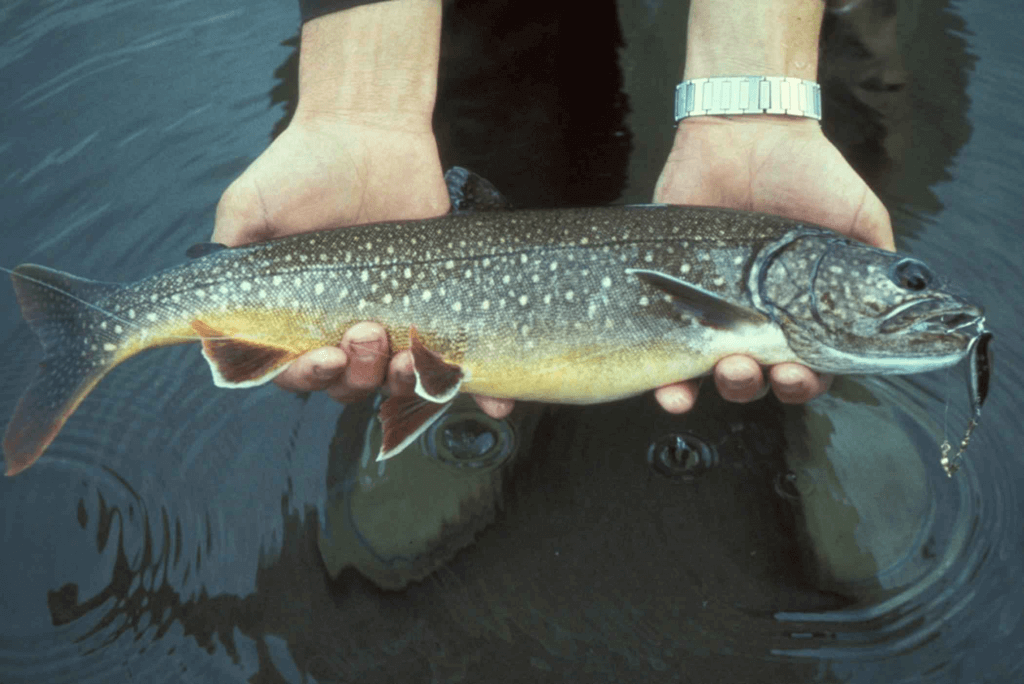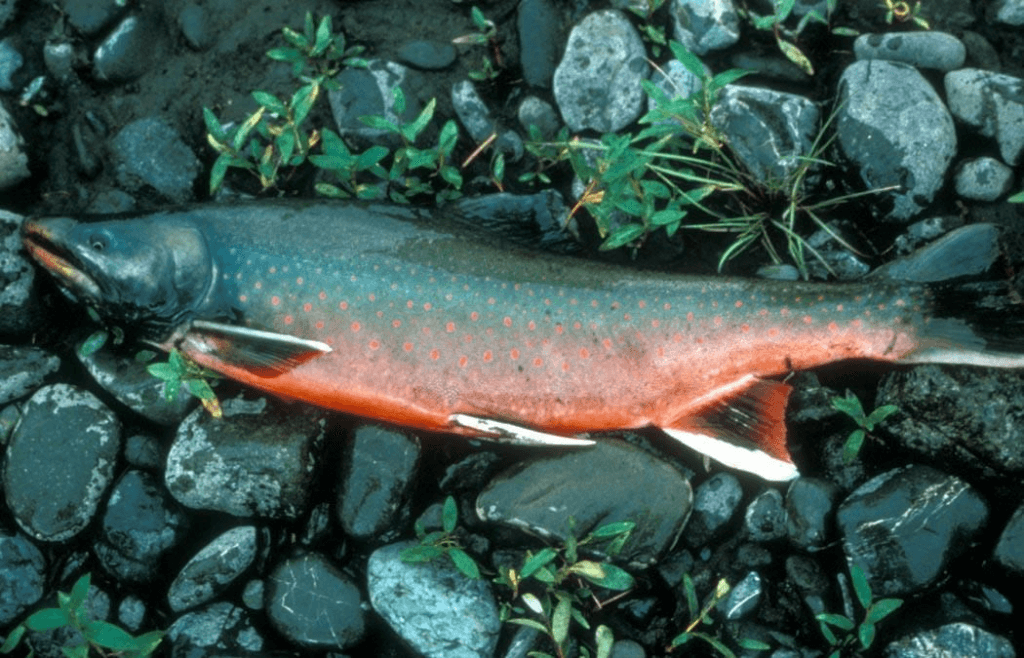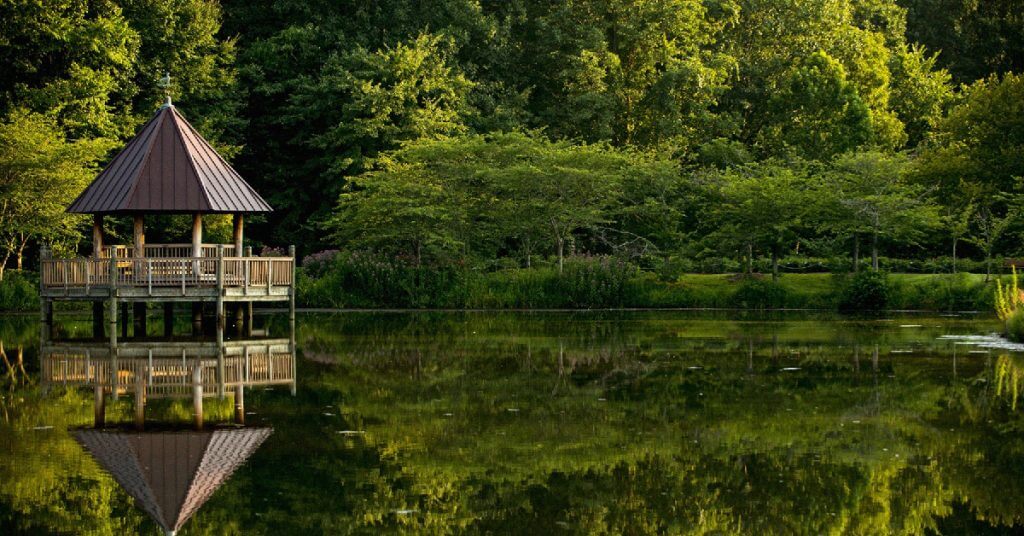Trout fishing has been my passion since before I could spell the word, and these 13 species still fascinate me. Let me share what makes each one unique.
Last updated: January 24th, 2025
Native Trout
If you’re a trout angler, chances are that you’ve caught a few of these no matter where you live in the country. These trout are great to eat, fun to fish, and readily available in streams, rivers, and lakes.
Rainbow Trout

Rainbow trout (oncorhynchus mykiss) are the undisputed kings of North American trout fishing. Their distinctive pink lateral stripe and black-spotted body make them easy to identify, along with their characteristic square tail (compared to the forked one of other trout).
Native to the west coast from Southern Alaska to Mexico, rainbow trout are now found throughout the western portion of the country.
Here on the East Coast, where I do most of my fishing, they’re all stocked populations. Throughout the northeast and as far south as Georgia, you can find stocked rainbow trout.
A lot of people confuse steelhead and rainbow trout. Steelhead trout are anadromous – spending a portion of their life in saltwater while returning to the rivers to spawn.
While their coloration, shape, lower fins, and mouth might be the same – their habits are much different.
The average mature rainbow trout will be about 16 inches long and can weigh between 2 – 8 pounds. The record is 48 pounds from a native rainbow trout caught in Canada.
Catching Rainbow Trout
Chasing these guys down isn’t hard as they live in rather standard environments being that they’re stocked in most of the places you find them.
They thrive in cool freshwater (55-60 degrees), especially around hard rock bottom and cover from downed or low-hanging trees.
I’ve caught them on various lures from insects and eggs to minnows and worms – they’re some of the least picky trout you’ll encounter.
Cutthroat Trout

During my travels out West, I’ve encountered countless cutthroat trout – North America’s second most popular trout species. They’re unmistakable with their ‘bleeding’ red lower jaw and scattered black spots, more spread out than those on rainbows.
Native to the western U.S. and Canada up to Alaska, these trout come in 11 different subspecies, with a lot of national parks even creating their own variations. They typically range from 6-20 inches and weigh about 4 to 5 pounds for mature fish.
Unfortunately, their habitat has shrunk over the last decade. Development, mining, livestock production, and dams have forced these beautiful fish to relocate.
Catching Cutthroat Trout
Since there is so much variation in species, the methods of catching them are very diverse. You’ll find cutthroat trout in clear lakes, rivers, and streams. They like hiding in downed and rotten wood cover.
In my experience, your best chance at catching them is using an ultralight reel and small larvae or nymphs, particularly around river pools.
They tend to move away from cover at night so fishing in the evening right at dusk is the best way to go.
Golden Trout

During my rare encounters with golden trout in the remote Rockies and Cascades, I’ve been captivated by their unique beauty. These small, golden-bodied fish with distinctive red stripes follow their own unique schedule, spawning through summer when other trout species are long finished.
They don’t start feeding until March or April due to their high-altitude habitat, and can get as big as 12 inches. Anything larger than that is considered extremely rare.
It’s important to mention that these are not the same as palomino trout which we will cover later on.
Golden trout are a native species of the American wilderness whereas palomino trout are genetically mutated from golden trout and will grow much larger in size.
Catching Golden Trout
The introduction of brook trout in the golden trout habitat caused professionals to designate golden trout as “threatened”. Since then many specific wilderness areas have been dedicated to golden trout.
These areas are located all throughout the Rocky Mountain region and the California Sierra Nevada.
I do not recommended targeting golden trout. Since they are a threatened species, there isn’t much information on how to catch them or the environment you should look in.
I suggest that if you catch a golden trout you handle it with extreme care and release it immediately.
Gila Trout

If you fish near the Gila River in the Southwest Corridor of the US, particularly the Gila National Forest, you might get lucky enough to stumble upon a Gila trout. You’ll find them in rivers and small streams throughout New Mexico and Arizona.
These small fish typically do not grow beyond 12 inches. They are distinguished by their bright gold bellies, copper gill plates, and a yellow cutthroat mark right behind their mouth. They also have small brown spots on the top.
They inhabit coldwater mountain streams that flow down. Look for them beneath fallen trees and in groundwater pools.
Note that these are another threatened species of trout that were once endangered due to invasive species.
Recovery efforts have since made it possible for these fish to thrive and the species is increasing more and more each year.
Catching Gila Trout
This is a different species that I recommend you practice proper catch and release. Let it go and handle it very gently. Their population remains vulnerable due to their harsh habitat.
While fishing techniques aren’t widely shared to protect the species, they’re still a magnificent sight to witness!
Apache Trout

Apache trout, which are rarer than the others on my list, have a smaller habitat only being found in high-elevation streams across Northern Arizona. They have an olive-colored body with a gold belly.
While they can reach 20 inches, most I’ve encountered in small streams stay under a foot.
It’s encouraging to see Arizona’s recovery efforts, including new stocking programs in Silver Creek Hatchery and the Little Colorado River. They spawn in spring gravel beds, reaching maturity at three years.
Catching Apache Trout
Unlike the other rare trout I’ve covered in this article, you can legally fish for and eat Apache trout with proper permits – both a state fishing license with trout stamp and often a tribal permit, as many waters are on Native American lands.
From my experience, these insect feeders can’t resist small spinners, especially Panther Martins. Natural-colored wet flies and grasshoppers are a common feed for this species.
Invasive Trout Species
Some species of bass, salmon, trout, and other gamefish are all native to other countries but were brought here with good intentions. Unfortunately, those good intentions don’t always work out and that’s the case with an invasive trout species.
Brown Trout

Despite their name, brown trout actually display golden coloring with orange spots and silver rings – looking more like their Atlantic salmon cousins than trout.
These hefty fish (salmo trutta) can reach 14 inches and weigh up to 20 pounds, often dominating the waters they share with smaller trout species.
If I compare brown trout versus brook trout, they’re much more tolerant of varying water temperatures and can live almost anywhere.
They feed heavily and because of their migration patterns, it makes them difficult to manage and control because they will feed and take over all the water they pass through.
Catching Brown Trout
Contrary to popular belief, I’ve found that brown trout aren’t that easy to catch. They’re a smart species and can identify the difference between natural prey and artificial lures. They’re typically surface feeders, favoring topwater spinners and dry flies.
Brown trout also don’t move around much and they prefer to stay in hiding rather than taking risks and popping out to check out your fly.
They’re not impossible to catch though and they put up a great fight when you do eventually hook one.
Char Trout: Are They Even Trout?
After years of hearing anglers debate this at the dock, I can tell you that char aren’t actually trout – they’re a member of the cold water salmon family of the Arctic. They are native to North America though.
I’ve learned to spot them by their distinctive dark bodies with light spots, the opposite of trout and salmon. They prefer generally cool water temperatures so you’ll have the best chance of finding them in the early spring and late fall.
Let me walk you through the four popular char species:
Brook Trout

These are some of the most popular trout available in the country. You’ll have to strap up your best waders because they prefer small streams and generally occupy areas of low-hanging cover.
Native to the northeastern U.S. and Canada, they are spread from Great Lake tributaries down to Georgia’s highlands, and even to Europe and Argentina.
Brook trout (salvelinus fontinalis) reach full maturity in two years but are capable of spawning after only one year. Their spawning season is between September and October which is typical for most North American “trout” species.
They grow to anywhere between 8 and 12 inches.
One of the reasons why they’re called “brook trout” is because they require highly oxygenated water to live. This means that they thrive only in moving water because all of the oxygen, minerals, and nutrients flow downstream from lakes and ponds and allows them to feed and thrive.
Catching Brook Trout
Brook trout feed on plankton and small insects so I tend to stick with things like worms, leeches, and insects.
As for catching them with a lure, I suggest going with rooster tail spinners or something similar. Make sure to keep the size small and anticipate not catching anything too crazy.
Most of the large brook trout don’t often come out to feed because the smaller ones have the numbers.
Lake Trout

Lake trout (Salvelinus namaycush) are the giants of the char family. They’re found in deep waters throughout the northern half of the country, in cold water reservoirs and lakes.
In Canada, they are a serious game fish compared to the muskie or walleye down here.
Lake trout are rare, a challenge to track down, and even more of a pain to get in the boat if you hook one. If you do, prepare for a fight.
What makes these fish interesting is their longevity – reaching 40 years in remote Canadian and Alaskan waters.
This means that you could luckily stumble upon something tremendously huge if you know where to go.
Also, just imagine eating a 40-year old fish for a second. It sounds amazing and also kind of gross at the same time.
While typically around 20 inches, they can stretch to an impressive 50 inches. Thanks to stocking programs, these challenging fighters now range beyond their native New England and Great Lakes waters.
Catching Lake Trout
In my experience, Lake Trout’s diet of crustaceans, insects, and baitfish makes them predictable feeders. It’s reaching them that presents the real challenge.
By the time you’re able to reach the appropriate depth in the water column, chances are, the other fish in the water will have already taken your bait or at least chewed it up to where the lake trout doesn’t want it now.
Bull Trout

One of the most striking chars I’ve encountered in the Pacific Northwest is the bull trout, a lake trout relative that extends into Southwest Canada. You can identify them through their copper-colored bellies, silver upper portion, brown eyes, and orange spots.
Matching their lake trout cousins in size, they commonly reach 25 inches, though some stretch to 40 inches, with lifespans around 15 years.
When we compare bull trout vs brook trout, their habitats are almost the same with one major difference. Bull trout are most common in near-arctic environments so you won’t find them as much in the US as you would throughout Canada.
Catching Bull Trout
Having tangled with these powerful fish, I can tell you bull trout respond best to natural baitfish presentations. Minnows, streamer flies, spoons, and crankbaits are your best bets.
Given their impressive size, don’t skimp on gear – a sturdy baitcasting reel and the right braided line are essential.
Dolly Varden Trout

The debate door is wide-open on this one and feel free to chew me out in the comments but I do believe that the Dolly Varden is its own species of trout. A lot of people think it’s the same as an Arctic Char and for that reason, I haven’t even included Arctic Char in my list.
But, I just find there to be enough differences to consider them each their own fish.
These fish range from Alaska through Canada into Northern Washington, and have even managed to cross the Pacific to establish populations in Japan and Siberia.
They’re not a huge species compared to Lake and bull trout but they’re bigger than your average brook and rainbow trout. They average about 10 pounds and you’ll identify them by their unique side stripe and spots.
The exact color of the stripe can vary but it usually looks like a teal color with pink spots. Other than that, they look a lot like a bull trout or species of cutthroat trout.
Catching Dolly Varden
I’ve found Dolly Varden to be aggressive strikers, particularly during spawn. They have a diverse diet of insects, larvae, and small fish.
My go-to setup for them is a light action rod with spinners or spoons. Powerbait also works well and I recommend going with all-natural salmon eggs.
The Hybrids: Crossing Over
There are a few interesting and unique hybrid species of trout available throughout North America and Canada. The chances of finding these are miniscule but I’ve seen some pretty crazy things.
Tiger Trout

Tiger trout, a hybrid cross between brook and brown trout, display their brook trout parentage through a distinctive worm pattern. While you’ll rarely encounter them in the wild, these aggressive 18-20-inch fighters are regularly stocked throughout the Great Lakes region.
They have an aggressive attitude that will make them bite a lot of different things.
Catching Tiger Trout
These guys can survive in a wide range of habitats because of their hybrid design so you can expect them to actively feed for most of the season.
I recommend going with spinners, spoons, and live bait because they don’t feed on insects, they only feed on other fish.
That makes tiger trout one of the only species of trout that you can’t catch with a fly.
Splake

Splake, another debated trout species, comes from crossing female lake trout with male brook trout. Their name blends ‘speckled’ and ‘lake,’ reflecting their mixed parentage.
Found mainly in the Midwest, these fast-growing fish are exclusively bred in controlled Canadian facilities since they don’t breed in the wild.
They have a more versatile appetite and can handle varying temperatures including very cold and slightly warm.
Catching Splake
Fly fishing, spin casting, bait casting, and trolling are all ways to catch splake.
These fish will bite almost anything and since they grow so fast they have a strong appetite and will feed a lot. Live bait such as fish eggs and small insects should work great as well.
Palomino Trout

Of all the trout species I’ve covered, palomino trout (or golden rainbow trout) stand out most dramatically – and not just for their bright gold-orange coloring. Don’t confuse them with the golden trout from earlier in the article.
These fish were genetically mutated and designed in captivity throughout the 1950s.
Their distinctive appearance and large size, while striking, unfortunately makes them vulnerable to overfishing.
Catching Palomino Trout
Within 25-50 miles of my hometown are sprawling rivers and streams known for housing incredible palomino trout. Pennsylvania is the ideal spot for catching these guys with some of them weighing as heavy as 13 pounds.
Palomino trout are highly sensitive and skittish so I recommend presenting something that is very mild. Don’t make too much noise with a loud outboard motor or a lot of movement.
I always fish these with a light action rod and quality reel, and keep a net handy for their powerful jumps in shallow water.
Final Thoughts
I covered 13 species of trout in this article. Out of all the types of trout here, most of us will only ever catch a few of them unless we’re very lucky.
That said, it’s nice to be informed and know a thing or two about different trout species so you can show off to your buddies and the guys down at the local tackle shop.
Trout fishing offers a diverse and exciting range of species to target. That’s probably the reason why, next to bass fishing, trout are one of the most popular sport fish out there.
If you have anything to add, feel free to leave a comment below – I read and answer them all!
Good luck out there!




